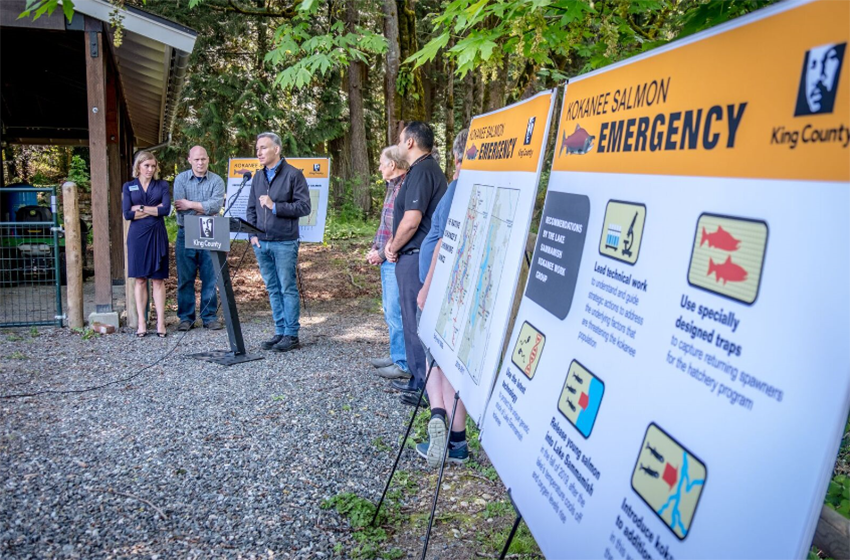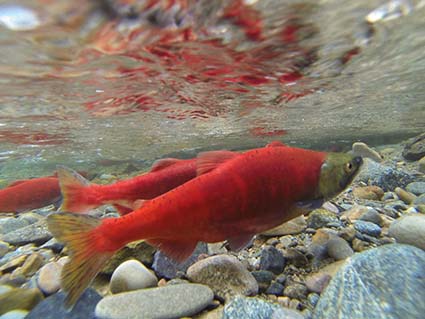Biologists see promising signs of health for native kokanee salmon four years after Executive Constantine announced actions to help ensure their survival
Summary
Biologists observed a sharp increase in the number of adult kokanee salmon returning to spawn four years after Executive Dow Constantine announced that King County would enact recommendations from the Lake Sammamish Kokanee Work Group.
Story

Biologists have seen promising signs of health in the population of native Lake Sammamish kokanee salmon four years after Executive Dow Constantine announced that King County would work with partners to enact emergency and long-range actions to help ensure their survival.

Last fall biologists observed more than 2,000 adult kokanee returning from the lake to spawn in tributary creeks, more than the total number of spawners they observed over the previous five years combined.
Executive Constantine in 2018 announced that the King County Department of Natural Resources and Parks would enact recommendations from the Lake Sammamish Kokanee Work Group to prevent the possible extinction of the native freshwater kokanee salmon after a sudden, alarming decline in spawners returning to streams around Lake Sammamish. County, state, and federal biologists counted fewer than 20 kokanee during the 2017 return.
“Four years ago we committed to taking immediate action to help ensure the survival of these iconic fish by mobilizing our combined resources and applying the latest science and technology – and today we are delivering on that shared vision,” said Executive Constantine. “This inspiring work by our staff and partners is producing promising results for a native salmon species that is important to our region’s habitat and history."
King County this winter completed an important step in one of the emergency actions when it flew nearly 12,000 kokanee eggs from an Orcas Island hatchery after a successful spawning operation there. The partners are also developing strategies to address the underlying factors that are threatening the salmon species, which includes non-native predators.
- Using specially designed traps to capture a small portion of returning spawners for the hatchery program
- Releasing young salmon into Lake Sammamish during the fall, after the lake’s temperature cooled and oxygen levels rose
- Using the latest cryopreservation technology to protect the unique genetic stock of Lake Sammamish kokanee
- Reintroducing kokanee salmon to additional creeks in the watershed using egg boxes, reducing the risk that a flood or drought in a single creek will wipe out the entire run
Biologists believe one contributing factor for the recent increase in returning spawners is King County, the City of Sammamish, and waterfront residents removing barriers to streams and tributaries. They each replaced traditional pipe culverts with what are known as box culverts, which are more like arches that allow streams to naturally flow under roads and trails.
A species important to the biodiversity of the region
In addition to being culturally significant, the native kokanee are important to the biodiversity of the region. They have a unique genetic signature, having adapted over centuries to the unique Lake Sammamish ecosystem, making them impossible to replace. It is one of only four known genetically distinct salmon populations in the state.
The kokanee run that occurs in November and December – known as the late run – is the focus of current conservation efforts. The run that that historically occurred in late August and September on Issaquah Creek was driven to extinction between the 1970s and early 2000s. The run that historically occurred in October and early November in Sammamish River and Lake Washington tributary streams was believed to be extinct as well, but very recent investigations may have located a small remnant of that population.
The Lake Sammamish Kokanee Work Group active membership includes the Snoqualmie Tribe, each of the five local jurisdictions in the Lake Sammamish watershed, the U.S. Fish and Wildlife Service, the Washington Department of Fish and Wildlife, Washington Department of Ecology, Washington State Parks, University of Washington – Bothell, Trout Unlimited, Mid-Sound Fisheries Enhancement Group, Mountains to Sound Greenway Trust, Friends of Issaquah Salmon Hatchery, Save Lake Sammamish, Friends of Pine Lake, Friends of Lake Sammamish State Park, and residents who live in the watershed.
Relevant links
- VIDEO: Return flight for offspring of native kokanee salmon
- VIDEO: Honoring a sacred commitment to ensure the survival of native salmon
- Lake Sammamish Kokanee Work Group
Quotes
Four years ago we committed to taking immediate action to help ensure the survival of these iconic fish by mobilizing our combined resources and applying the latest science and technology – and today we are delivering on that shared vision. This inspiring work by our staff and partners is producing promising results for a native salmon species that is important to our region’s habitat and history.
We are excited that our science-based salmon recovery efforts are paying off with a strong kokanee return in 2021. This kokanee partnership is central to the city’s identity, our thriving economy and our healthy environment, and it helps a culturally important native fish species come back from the brink of extinction.
For more information, contact:
Doug Williams, Department of Natural Resources and Parks, 206-477-4543

 Translate
Translate